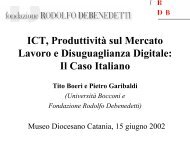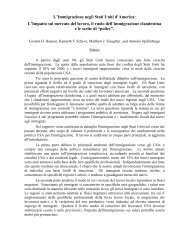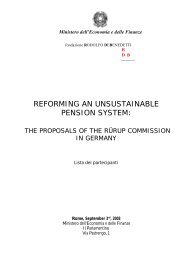The Executive Compensation Controversy - Fondazione Rodolfo ...
The Executive Compensation Controversy - Fondazione Rodolfo ...
The Executive Compensation Controversy - Fondazione Rodolfo ...
You also want an ePaper? Increase the reach of your titles
YUMPU automatically turns print PDFs into web optimized ePapers that Google loves.
THE EXECUTIVE COMPENSATION CONTROVERSY: 24 MAY 2010A TRANSATLANTIC ANALYSISthe CEO through cash compensation or non-qualified stock options, and €1.57 to convey €1in qualified stock options. Thus, for executives and companies in the highest tax brackets,qualified stock options became tax disadvantageous compared to non-qualified stock options,and (as illustrated in Figure 2.7) have remained so throughout the early 2000s. Restricted orqualified stock options – which had been the dominant form of long-term incentives for twodecades – virtually disappeared from existence.Congress resurrected a new form of qualified options (now called “Incentive StockOptions” or ISOs) as a last-minute addition to the Economic Recovery Tax Act of 1981. 40ISOs carried many of the restrictions common for qualified stock options (holding periodsafter exercise, minimum exercise prices, etc.), and in addition were limited to $100,000 perexecutive per year (calculated as the stock price multiplied by the number of options on thedate of grant). While ISOs have continued to be popular in the 2000s for middle-levelmanagers (where the $100,000 limitation is not binding) and for companies without taxableprofits (where loss of deductibility for ISOs is not costly), virtually all options granted toCEOs and other top executives since 1972 have been non-qualified stock options.2.4.2. <strong>The</strong>reʼs No Accounting for Options (1972-2005)<strong>The</strong> restricted and qualified stock options created by the 1950 and 1964 Revenue Actswere not formally considered “compensation” and therefore companies did not record anexpense for such options for either tax or accounting purposes. <strong>The</strong> switch to non-qualifiedoptions in the 1970s – which were considered compensation for tax purposes – raised a newquestion: how should options be accounted for in company income statements? Onepossibility was to follow the tax code and recognizing an accounting expense at the time anoption is exercised. But, in spite of its simplicity, this method is inconsistent with the basictenet of accounting that expenses should be matched to the time period when the servicesassociated with those expenses were rendered. Rather, the tenet suggested that options shouldbe expensed over their term based on the grant-date value of the option. At the time, however(and for a long time to come) there was no accepted way of placing a value on an employeestock option.In October 1972, the Accounting Principles Board (APB) – the predecessor to thecurrent Financial Accounting Standards Board (FASB) – issued APB Opinion No. 25,“Accounting for Stock Issued to Employees.” Under APB Opinion No. 25, the compensation40 Bettner, “Incentive Stock Options Get Mixed Reviews, Despite the Tax Break <strong>The</strong>y Offer <strong>Executive</strong>s,”Wall Street Journal (August 24, 1981), p. 32.-31-









